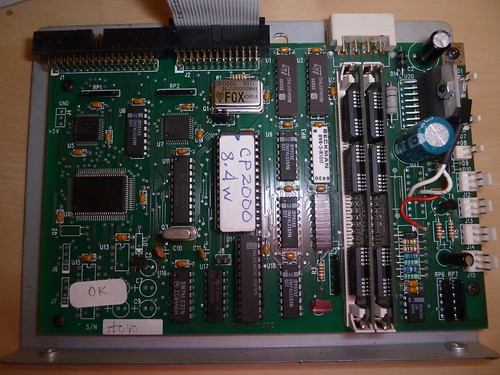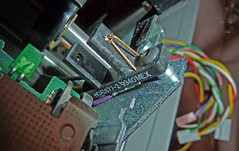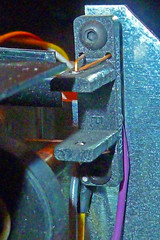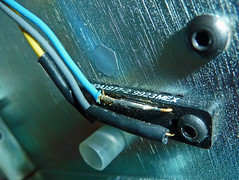So now I'm waiting on a motor controller, some connectors, stripboard, I've been slightly busy attempting to read datasheets..
What is a CopyPro 2000? why is it useful? Read on..
Well.. its a rather industrial looking bit of kit.. intended to run as a standalone floppy duplicator.. here's a quick video of it in action..(safety guards have been removed for educational purposes..)
Somewhere around 50 seconds in, you see it spit out the green disk it had been reading & remembering.. and grab a new black disk from the stack.. which it then wrote the green disks data to.. isn't that just a thing of beauty?
No?
Ah well.. clearly you haven't attempted to build a Floppy autoloader out of Lego.. I have.. and this thing is a touch more refined than my result =)
Of course, the CopyPro didn't turn up all nice and working.. I got it pretty much sold as seen, without its normal floppy input chute, or output collector chute.. I figure these can be built from mdf later. More importantly, it arrived with a dead floppy drive fitted (eek! seems it's spindle motor was dead) and it didn't look too normal.. a Ye Data YD-701B-6331S .. with about 20 customisable jumpers. This could have been bad, if the jumper configuration meant the drive wasn't working like a 'normal' drive, my chances of seeing the CopyPro do it's thing could be pretty small.
Given the large stack of floppy drives I have.. I tried a couple, and thankfully, it seems there wasn't anything too special about the old one.. or if there was, the controller was smart enough to figure it out.
So that resulted in the quick video.. and proof that the "CP2000 8.4W" firmware is only smart enough to clone DOS formatted floppies.. testing with an Amiga disk quickly showed it wouldn't tolerate them as source disks at all. I tried throwing an email to the company who built it.. but they haven't replied.. not much chance they will either, since I don't really want to use it, but dismantle it.
Heres the plan.. remove the old controller board..

and have an Arduino take over it's duties.. well.. some of.. the floppy output will go to a PC, via a Kryoflux which is kinda like a finished-project version of my floppy reader, combined with some decent interpretation of the data in software.
What did that brain-board have to do?
- Connect to the floppy drive to read/write data.
- Communicate with the front panel pcb to show status LEDs, LCD text, and get Button presses.
- Read a sensor checking if the disk exit from the unit is blocked
- Read a sensor at the disk mouth, seeing if a disk is stuck inserting/ejecting
- Monitor a sensor determining if the insert/eject mechanism is fully retracted.
- Drive a motor, performing the insert/eject.
- Power a solenoid selecting the good/bad disk exit path.
The main board of the CopyPro 2000 used a L298 (visible top right, where the 2 white & red cables go to the thing with a nut thru it) to drive the Motor & Solenoid. Conveniently, that same controller is used at the core of many motor driver shields for the arduino.. even better, the one on this board has no heatsink, which means the power through it is pretty limited. (Although it does have the equivalent of a thermal cutout bolted to it.. but I suspect thats to stop it cooking inside the enclosure in a warm place..). One DFRobot Motor controller sourced off ebay.. (details) .. The motor controller will take over driving the motor, and the solenoid.
Next the sensors..



All 3 are optical slot sensors, (2x HO1877/2 1x OPB830W55) each pairing an IR Diode with a Phototransistor.. the tricky bit being figuring out their orientation.. determined by the little white spot.. which I finally caught on camera with a bit of macro zoom.
In theory, I just power up all the IR Diodes.. (datasheets for the components call for 16 or 17ma current for the diode), then slap a pull up (or down) resistor before (or after) the transistor side, and connect an ardino pin to the middle of the resistor/transistor.. configure it as input, and I should see it go high or low when the sensor gets blocked / unblocked.
Then I just need to wire all that on some stripboard, provide pin headers for the sensors/motor, power input, carefully write some stuff to drive the motor, respond to the signals from the sensors, and I have my own host-controlled floppy autoloader.
While it'd be great to try to reuse the entire front panel too.. there's a lot of work to figure out that panel, and it may just be simpler to remove it, and put my own LCD display with a few LEDs in there. (Plus there's the slight issue that I can't find a hex key small enough to detach it from it's mounts at the mo.. making it tricky to trace the circuits)
Next update on this once the motor controller & other bits arrive.. this one should be fun!

No comments :
Post a Comment